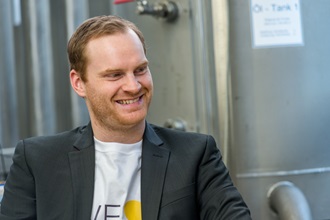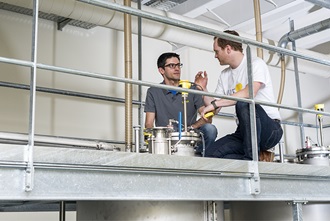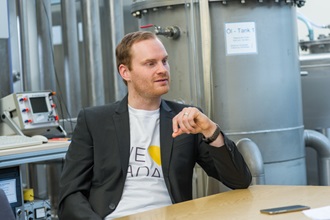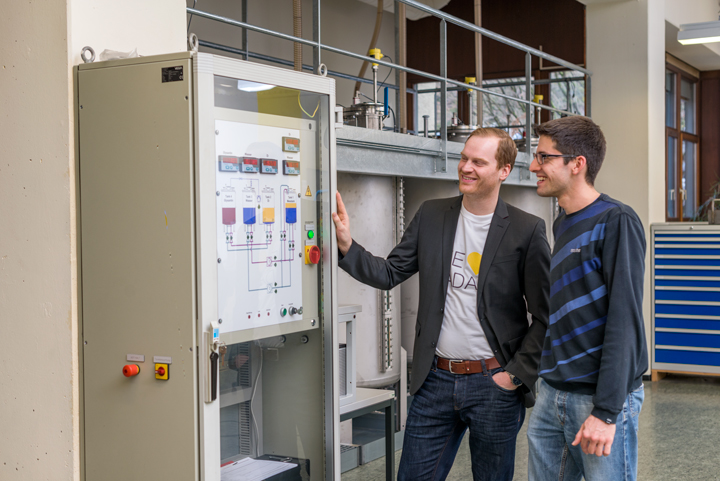Interview: Tobias Aberle
How long have you been at VEGA?
I started in January 2005. Of these 12 years I’ve worked 7 years in the internal sales department, it provided me with excellent experience with our products and an understanding of what our customers really want. Now, for the last month I have started working in the field sales team.
Now you are a new member of the field sales team, what experiences have you had with our 80 GHz radar VEGAPULS 64?
I’ve had many very good experiences. Especially in field sales, it has been fun to participate in promoting and demonstrating a completely new product. Customer response has been fantastic and demand is very high, we get consistently positive feedback – especially in conjunction with the Bluetooth display and adjustment module, PLICSCOM.
You can now tackle many applications that just would not have been possible before. The capabilities of level measurement technology have really been extended. I have had a lot of positive experience in this area.
Yes, and one great success is non-contact level measurement inside cramped installations. Its focusing is absolutely unbeatable for this.
Recently, I put a VEGAPULS 64 into operation measuring the level down a fairly narrow shaft – it was only 50 - 60 cm wide, around 5 or 6 m deep and it had an access ladder leading to the bottom! The sensor’s tight focusing really made the difference – as the level measurement performance was excellent.
20 cm in diameter. The fact that you can measure in there at all, in spite of all the interfering reflections, has really inspired me.
And then of course there’s also the incredible dynamic range of our radar. When you look at the topic of bulk solids there is often a problem of poor reflectivity. So, what we’ve achieved with 80 GHz radar level sensors on polystyrene: those tiny fluorescent plastic balls, is what has convinced me the most. It’s a huge step forward that the level measurement signals have become much stronger and more reliable.
For what areas do you recommend other measuring principles?
There is no blanket answer to that question. It makes no sense to use radar if the customer needs to measure bulk solids exactly to the kilogram. Or if the installation conditions do not allow radar, i.e. if you cannot measure from above. In many cases, several different factors are involved. Of course, one important point is, the price. If you can get a capacitive electrode or a pressure transmitter for half the price of a radar, that’s a big deal. For very simple applications a radar based device simply overkill. That's why VEGA will always offer a range of technologies, and experienced advice to go with them.
A lot of advertising was done for this instrument. Do the adverts keep what they promise?
In the overwhelming majority of cases, yes. We say that foam is no longer a problem, but in reality it’s not that simple. It depends on various factors and foam can indeed be a knock-out factor under certain conditions.
Can you recommend the radar sensor for measurement in long mounting nozzles?
Yes, I can. Absolutely. However, it still makes sense to keep the nozzle or upstand as short as possible. But that's not a knock-out factor like it used to be. What we will always recommend is to make sure the lower end of the socket is smooth and burr-free, it’s good engineering practice and it discourages any long-term buildup and blockages. Apart from those few things you have to watch out for, measurement through a mounting socket is now as easy as ABC.
Yes, for sure. The dynamic range I mentioned earlier is the main advantage in bulk solids applications. For liquids, it’s more about the good focusing - but it can be a bit of both in either field. But the fact that we can get a reliable level signal at all from very poorly reflecting bulk solids, is amazing and has to be attributed to the wide dynamic range we have developed.
Why do you love Radar?
I guess it’s because of the beauty of the technology itself (winking).
I love radar because it is an exciting and wide-ranging measuring principle that can be used so universally.
We work day in and day out with radar technology. That’s why we know a lot about it and why it has practically become my hobby to find out
more and more. I would really be missing something if I had to go to a customer without radar. I would feel like saying say no, I just can’t go! So I’m sure you can see why it is one of my favourite measuring principles, and I wouldn’t want to work without it.
Export this article
Download as PDFShare this article
Comments ({{comments.length}})
{{getCommentAuthor(comment, "Anonymous")}} {{comment.timestamp | date : "dd.MM.yyyy HH:mm" }}
{{comment.comment}}





